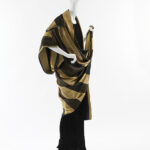The fashion world mourns the loss of Manfred Thierry Mugler, the iconic French fashion designer whose groundbreaking vision redefined power dressing in the 1980s, pioneered the concept of celebrities as models, and revolutionized the fragrance industry with Angel. He passed away on Sunday, January 23rd, 2022, at the age of 73, leaving behind a legacy that continues to inspire and influence contemporary fashion.
Throughout his illustrious career spanning decades, Thierry Mugler collaborated with an array of luminaries, from Hollywood icons like Diana Ross, Tippi Hedren, and Demi Moore to contemporary pop culture figures such as Beyoncé, Cardi B, and Kim Kardashian West. Kim Kardashian West notably captured global attention in a striking “wet-look” latex corseted dress designed by Mugler at the 2019 Met Gala, a testament to his enduring ability to create viral fashion moments.
Mugler distinguished himself as a disruptor of traditional fashion norms, notably by democratizing the fashion show experience. In 1984, he broke with convention and opened the doors of his show to the public at the Zenith concert venue, transforming the runway into an accessible spectacle. His innovative approach extended to his designs, where he fearlessly experimented with unconventional materials like latex, metal, and feathers, pushing the boundaries of clothing construction and challenging established aesthetics.
In 2002, Thierry Mugler stepped away from the fashion industry, choosing to concentrate on fragrance development and costume design. Reclaiming his birth name, Manfred, he also embarked on a personal journey of physical transformation, embracing plastic surgery and bodybuilding.
Born in Strasbourg, France, Mugler’s formative years in fashion began in London, where he contributed to the vibrant Swinging Sixties scene. He credited this period with fostering his creativity and inventiveness, immersing him in a dynamic social environment where fashion was a central form of expression. Later, Paris became a pivotal influence, shaping his signature streamlined and body-conscious aesthetic. He acknowledged Cristóbal Balenciaga and Christian Dior as his “masters in fashion,” drawing inspiration from their Parisian elegance and sophistication.
“Fashion took off for me very quickly in Paris, as soon as I showed my sketches,” Mugler recounted, recalling the fashion landscape of the time dominated by folkloric trends. In contrast, he pursued a “very pure, Parisian silhouette,” characterized by “the little black suit, the trenchcoat, the black dress, the siren dress.” He pioneered the “nude body-conscious dress” at a time when the concept was unprecedented. His first ready-to-wear line, Café de Paris, epitomized this precise, streamlined silhouette, deeply influenced by the art of dance.
Although he officially ceased designing clothing in 2002 following the closure of his ready-to-wear brand by Clarins, Mugler remained active in the perfume sector. The Mugler ready-to-wear line was revived in 2010, marking a renewed chapter for the brand.
In a September interview, Mugler hinted at forthcoming fragrance projects and his dedication to a personal exhibition of collages and photos in Berlin, alongside continued work in ballet costume design, showcasing his multifaceted creative pursuits beyond fashion design.
The Musée des Arts Décoratifs in Paris hosted a significant retrospective of his work, “Thierry Mugler: Couturissime,” which opened in September with a celebratory event attended by Cardi B. This landmark exhibition, the first major one in Paris dedicated to the designer, followed successful runs in Montreal, Rotterdam, and Munich, highlighting the global recognition of Thierry Mugler French Fashion Designer.
Mugler expressed his delight at the exhibition, noting its harmonious curation of his work and its connection to sculpture, painting, and other decorative arts. The exhibition featured approximately 150 garments from 1977 to 2014, alongside a rich collection of photographs, underscoring his role as a seminal image-maker of the 1980s who revolutionized the fashion show into spectacular, Broadway-esque productions starring iconic figures like Diana Ross and Jerry Hall.
Olivier Gabet, director of the Musée des Arts Décoratifs, emphasized Mugler’s prescient vision, recognizing him as “ahead of his time in many ways, from the phenomenon of celebrity-as-model to his relationship with the music world, and the cultural impact of fashion in contemporary society.” He lauded Mugler’s intuitive, artistic, and sometimes “animal” approach to communication, contrasting it with conventional marketing strategies.
Thierry-Maxime Loriot, the curator of the exhibition, mourned Mugler’s passing, hailing him as a “true avant-garde artist” who proved the power of originality over trends. He celebrated Mugler’s timeless and humanist fashion, filled with humor and dedicated to celebrating individuality, influencing generations. Loriot emphasized Mugler’s groundbreaking inventions that revolutionized haute couture and his indelible mark on fashion history.
Sandrine Groslier, global brand president of Mugler fashion and fragrances, who collaborated with Mugler for 27 years, remembered him as a “genius jack-of-all-trades” who profoundly impacted fashion and beauty. She fondly recalled his humor, passion, and occasional eccentricity, as well as his deep respect for women.
Casey Cadwallader, the current creative director at the house of Mugler, expressed his profound honor in knowing and working within Mugler’s “beautiful world.” He acknowledged Mugler’s transformative impact on perceptions of beauty, confidence, representation, and self-empowerment, emphasizing that Mugler’s legacy guides his own work.
Thierry Mugler’s passing marks the end of an era but his innovative spirit and bold designs continue to resonate, solidifying his place as a legendary French fashion designer who forever altered the landscape of fashion.
